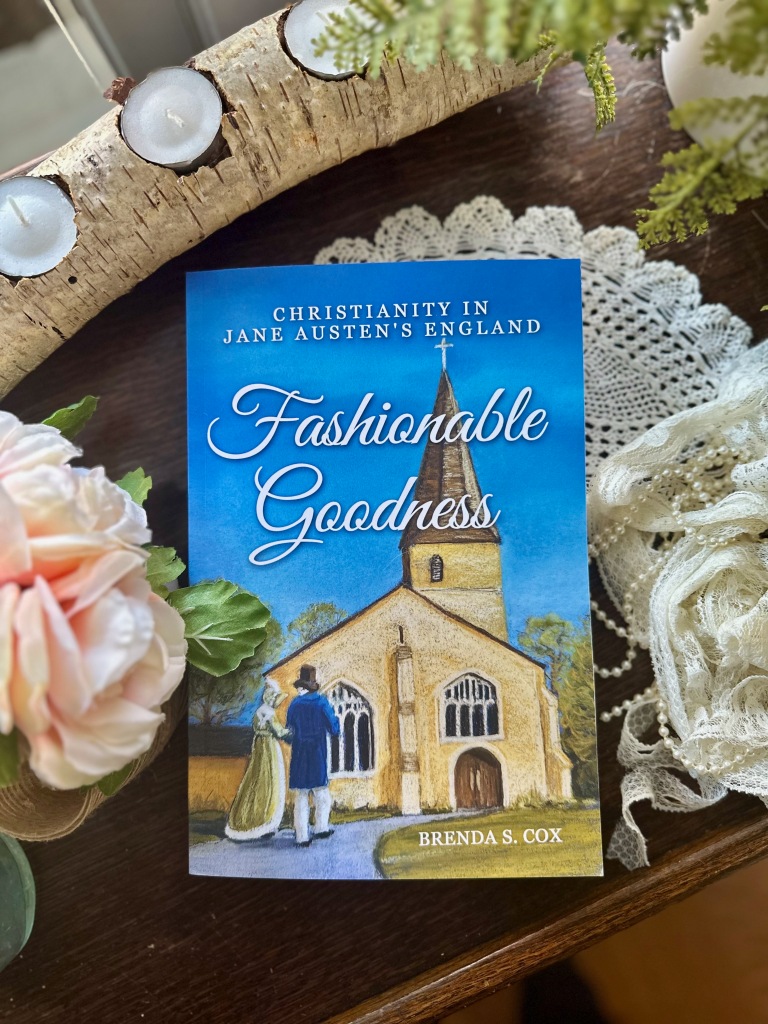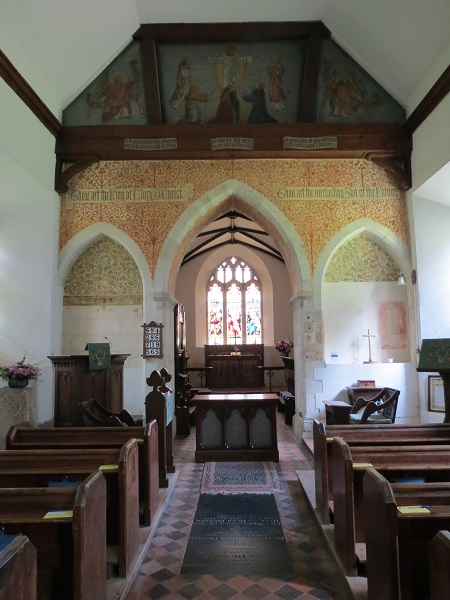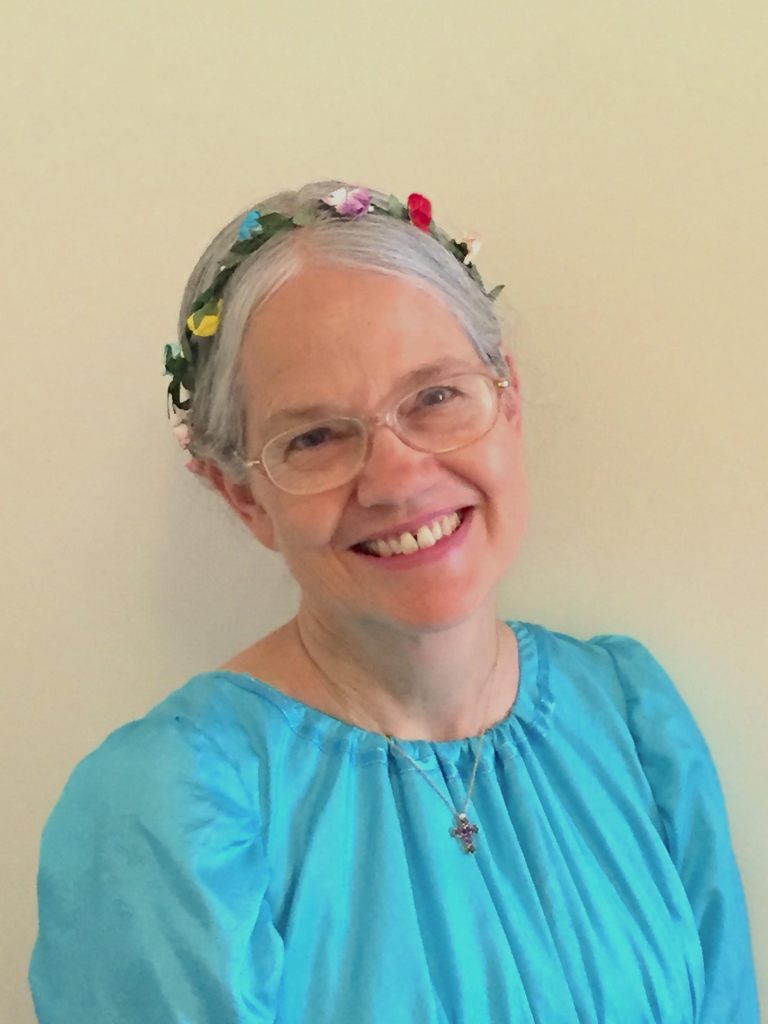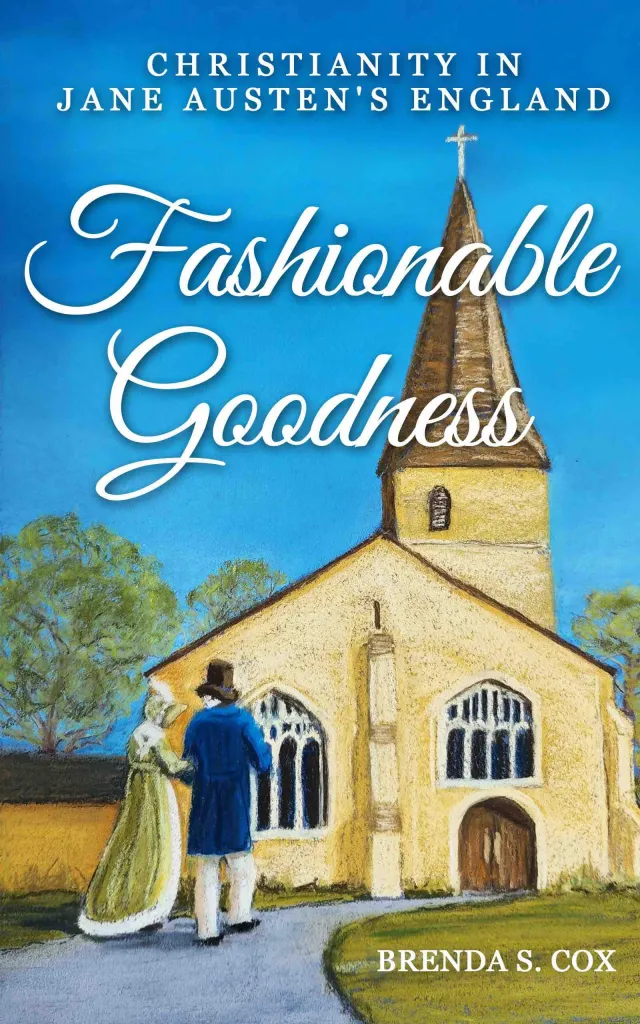Our very own Brenda S. Cox has just published her new book Fashionable Goodness: Christianity in Jane Austen’s England. It’s already receiving a wonderful reception, and I know it will continue. For those of us who are always expanding our understanding of Jane Austen’s life, and particularly her personal life and faith, this new book is an essential resource.
When I was writing my book Praying with Jane: 31 Days Through the Prayers of Jane Austen, I read every article and book I could find on the topic of religion and faith as it related to Austen and her family. I scoured every available resource on Austen’s personal faith, her family’s daily and weekly religious habits, and the Anglican church at large. I discovered many wonderful details about her religious life, but as I worked, I always felt as though I was putting together a giant puzzle. And when it came to understanding more fully the implications of her religious beliefs and background in her novels, I felt as though the puzzle was missing many important pieces.
In Fashionable Goodness: Christianity in Jane Austen’s England, Brenda has finally put the puzzle pieces in their rightful places and collected all of the information one might want to know about Jane Austen’s religious life in one handy place. This book covers a broad range of topics that any Jane Austen lover can benefit from knowing, especially for those of us who enjoy looking into the varied layers and greater context of her writing.
Of particular interest is the clever manner in which Brenda has organized the information in this book. Each chapter is easy to find, plus she has included many helpful resources at the end of the book, including handy tables with income information, terminology, ranks within the church, and denominations; several appendices; detailed chapter notes; a hefty bibliography; a glossary of terms; and a topical index. You can read this book cover-to-cover or you can pick and choose the topics that interest you most.
I highly recommend this book for any Austen fan or scholar. Without this book, you can only know part of what makes Jane Austen’s characters and plots so intriguing. Thank you Brenda for creating this invaluable resource!
(See below for giveaway details.)
About the Book:
“Brenda Cox’s Fashionable Goodness is an indispensable guide to all things religious in Jane Austen’s world. . . . a proper understanding of 18th century Christianity is necessary for a full appreciation of Austen’s works. Cox provides this understanding. . . . This work will appeal to novice readers of Austen as well as scholars and specialists.”
Roger E. Moore, Vanderbilt University, Jane Austen and the Reformation
The Church of England was at the heart of Jane Austen’s world of elegance and upheaval. Fashionable Goodness: Christianity in Jane Austen’s England explores the church’s role in her life and novels, the challenges that church faced, and how it changed the world. In one volume, this book brings together resources from many sources to show the church at a pivotal time in history, when English Christians were freeing enslaved people, empowering the poor and oppressed, and challenging society’s moral values and immoral behavior.
Readers will meet Anglicans, Dissenters, Evangelicals, women leaders, poets, social reformers, hymn writers, country parsons, authors, and more. Lovers of Jane Austen or of church history and the long eighteenth century will enjoy discovering all this and much more:
- Why could Mr. Collins, a rector, afford to marry a poor woman, while Mr. Elton, a vicar, and Charles Hayter, a curate, could not?
- Why did Mansfield Park‘s early readers (unlike most today) love Fanny Price?
- What part did people of color, like Miss Lambe of Sanditon, play in English society?
- Why did Elizabeth Bennet compliment her kind sister Jane on her “candour”?
- What shirked religious duties caused Anne Elliot to question the integrity of her cousin William Elliot?
- Which Austen characters exhibited “true honor,” “false honor,” or “no honor”?
- How did William Wilberforce, Hannah More, and William Cowper (beloved poet of Marianne Dashwood and Jane Austen) bring “goodness” into fashion?
- How did the French Revolution challenge England’s complacency and draw the upper classes back to church?
- How did Christians campaigning to abolish the slave trade pioneer modern methods of working for social causes?
About the Author, Brenda S. Cox:
Brenda S. Cox has loved Jane Austen since she came across a copy of Emma as a young adult; she went out and bought a whole set of the novels as soon as she finished it! She has spent years researching the church in Austen’s England, visiting English churches and reading hundreds of books and articles, including many written by Austen’s contemporaries. She speaks at Jane Austen Society of North America meetings (including three AGMs) and writes for Persuasions On-Line (JASNA journal) and the websites Jane Austen’s World and her own Faith, Science, Joy, and Jane Austen.
Buy the Book:
You can purchase Fashionable Goodness: Christianity in Jane Austen’s England here:
Amazon and Jane Austen Books
International: Amazon
Book Giveaway:
To enter for a chance to win a copy of Brenda’s book Fashionable Goodness: Christianity in Jane Austen’s England, please leave a comment below with an answer to this question:
What is one question you’ve always had about Jane Austen’s faith or the role religion plays in her novels?
Giveaway Details: This giveaway is for ONE (1) print copy and ONE (1) ebook (Kindle) edition for readers of this blog. The winners will be drawn by random number generator on November 18, 2022.
Note: This giveaway is limited to addresses in the U.S., U.K., Australia, Canada, Germany, Spain, France, or Italy for a print copy of the book. The author can only send a giveaway ebook (Kindle) to a U.S. address. (However, both the ebook and paperback are available for sale to customers from any of these countries, and some others that have Amazon.)
Blog Tour Schedule
- Oct. 20 Jane Austen’s World, Vic Sanborn, Interview
- Oct. 21 My Jane Austen Book Club, Maria Grazia, Book Giveaway and Guest Post, “Sydney Smith, Anglican Clergyman and Proponent of Catholic Rights, Potential Model for Henry Tilney”
- Oct. 22 Clutching My Pearls, Lona Manning, Book Review
- Oct. 23 Jane Austen Daily on Facebook, Austen and Her Nephews Worship (1808)
- Oct. 25 Fashionable Goodness Book Excerpt and Giveaway, Jane Austen in Vermont, Deborah Barnum, Book Giveaway, Review, Excerpt from Chapter 1, and Interview
- Oct. 25 “Jane Austen and Fashionable Goodness,” History, Real Life and Faith, Michelle Ule, Book Review
- Oct. 27 Australasian Christian Writers, Donna Fletcher Crow, Guest Post, “Seven Things Historical Fiction Writers Should Know about the Church of England”
- Oct. 30 Regency History, Andrew Knowles, Book Review and Video Interview with the author
- Nov. 1 So Little Time, So Much to Read!, Candy Morton, Guest Post, “Women as Religious Leaders in Austen’s England”
- Nov. 2 Fashionable Goodness and Jane Austen’s Use of Faith Words, Austen Variations, Shannon Winslow, Interview and Review
- Nov. 3 Laura’s Reviews, Laura Gerold, Book Review
- Nov. 4 Jane Austen’s World, Rachel Dodge, Book Review and Book Giveaway
- Nov. 5 Kindred Spirit, Saved by Grace, Rachel Dodge, Book Review
- Nov. 7 The Authorized Version, Donna Fletcher Crow, Book Review and Excerpt
- Nov. 8 Inspired by Life and Fiction, Julie Klassen, Book Review and Guest Post, “Jane Austen at Church”
- Jan. 10 The Calico Critic, Laura Hartness, Book Review
RACHEL DODGE teaches college English classes, gives talks at libraries, teas, and book clubs, and writes for Jane Austen’s World blog. She is the bestselling author of The Little Women Devotional, The Anne of Green Gables Devotional and Praying with Jane: 31 Days Through the Prayers of Jane Austen. Coming soon: The Secret Garden Devotional! You can visit Rachel online at www.RachelDodge.com.













Congratulations, Brenda, on publishing this immense amount of scholarship in one book. I can’t wait to find out which characters exhibit true honor.
Thanks so much, Patty! Who do you (or other readers) think was the most honorable man in Austen’s novels?
Brenda, I vote for Robert Martin.
Brenda, here’s my question. What did Jane think about other religions besides Christianity such as Judaism or Islam? Is there anything you saw about this in the vast amount of letters and papers that you read for the book? Jane may have been aware of Napoleon’s views on Judaism earlier in France and the benefit of a more liberal stance to the economy. His actions were practical.
Patty, I was just checking again through Austen’s works (novels, letters, everything) for any mention of Jews. In Northanger Abbey, the very vulgar John Thorpe does twice use the expression “rich as a Jew.” Which would tend to tell me that Austen did not approve of such expressions (and prejudices). But it’s really not enough evidence to tell us anything conclusive about Austen’s attitudes. My book, of course, is focused on Christianity, but I have included a few contemporary mentions of Jews and given a summary of their situation and numbers.
I find no mention at all of Muslims or Islam in Austen’s writings, and there are only a few mentions in my book. However, a fascinating book on some Muslim visitors to England during Austen’s time is Nile Green’s The Love of Strangers: What Six Muslim Visitors Learned in Jane Austen’s London. The book left me wishing for more, which the author was not able to provide, but still it gave an interesting view of Muslim visitors at the time and some hints of what they thought about the Christians in England. http://www.amazon.com/Love-Strangers-Students-Learned-Austens/dp/0691210403/
Brenda, since you found almost no references to answer my question, I wonder if Jane’s thoughts on the topic were in letters jettisoned by Cassandra? It makes sense Jane would have opinions on this topic since other contemporary literary figures covered it more extensively.
Patty, we can speculate so much on what might have been in those letters! Or even on what she said to Cassandra when they were together in person. As my book mentions, Jane could have met Jews in Southampton, London, or elsewhere. There were also a small number of people from the Indian subcontinent, likely including Muslims, in England at the time. But as far as we know, Austen’s thoughts on these religions were not recorded for us. :-(
If you want to imagine, though, a few JAFF (Jane Austen Fan Fiction) writers have re-imagined her stories in the context of Jews of her time, or Muslims of the present. Mirta Ines Trupp has written variations including Jewish families. See, for example, The Meyersons of Meryton, which I reviewed at https://wp.me/p9eTKH-Af. Modern variations set in Muslim contexts, which have some cultural similarities to Austen’s time, include Soniah Kamal’s Unmarriageable (see my review at https://janeaustensworld.com/2020/02/05/an-interview-with-soniah-kamal-author-of-unmarriageable-pride-and-prejudice-in-pakistan-by-brenda-s-cox/), and Uzma Jalaluddin’s Ayesha at Last (which I plan to review soon, Lord willing).
Thank you, Rachel, for this beautiful article. Congratulations to Brenda on the new book! My question is, why are clergy livings “in the gift” of certain land owners like Colonel Brandon, Lady Catherine, Mr. Darcy, and Sir Thomas. And why do some, like Mr. Darcy have “extensive patronage in the church”? That is, why do some landowners like Mr. Darcy have the power to “dispose of” several livings, or church postings, as we would call them? And why do they have the power to sometimes give more than one position to a single “incumbent” or minister, just as in the case of Edmund Bertram, who receives the livings at Thornton Lacey and Mansfield in due time? I know that these sometimes valuable clergy positions were often held for relatives of landowners. But why did they have the power to appoint the ministers? Or how did they do it? Thank you, Brenda!
Hi, Matthew! Great questions, which are explored in depth in my book, but I’ll summarize briefly here. Certain people (the crown, landowners, schools, and cathedrals, mostly) held advowsons, the right to assign the living (as rector or vicar, determined by long custom) for a certain parish. These advowsons were inherited, bought, and sold. They might also be transferred with dowries. So some people, like Lady Catherine and Darcy, ended up holding multiple advowsons and could assign the livings for several parishes. (The advowsons started out, in feudal England, belonging to the lord of the manor, who built the church for his people and hired the clergyman. Over the years these advowsons were transferred as property, and ended up owned by various people.) I hope that helps . . . By the way, this is still true in England, for some parishes; a certain person holds the advowson and makes the final decision on a clergyperson for a parish, though the bishop and the church are also involved in the decision now.
How interesting. The process is so different than what we are familiar with today. The truth is, the wealthy still exert disproportionate influence in church life, however fewer of them participate today. Thank you for making everything so clear, Brenda. I can’t wait to hold a copy of your book, and I look forward to pouring over it.
Thanks, Matthew! I trust you’ll enjoy the book. One more note on this–an English clergyman joined one of my online talks. We asked him to tell us about how he got his parish position. He said a group of people sat down together, including representatives from the bishop and from the church, but one lady (I think she was actually a Lady), introduced herself as, “I am Lady . . . , and I will be choosing the rector for this parish.” So, while there are modifications, the patronage system is still alive and well!
Was there any discussion in Austen’s time of the financial situation of a clergyman’s dependents after his death?
Dorothy, thanks for your question. Yes, we see in MP what happened to Mrs. Norris after her husband’s death, her brother-in-law took care of her. There were organizations to help indigent widows of clergymen, whose income of course ceased when their husbands died. We also see Mrs. Bates in Emma living on a pittance, and we know Jane and her mother and sister struggled after her father’s death, so she was very aware of this issue. My book explores it much more.
Thank you Brenda. Hope your book does very well!
Thanks very much, Dorothy! Blessings to you.
Brenda, thank you for writing on such a significant topic in Jane Austen’s life! Since I haven’t read the book yet, how much did Jane truly sympathize with Catholic traditions and artifacts?
Erna, the best way to answer this question is to refer you to Roger E. Moore’s excellent Jane Austen and the Reformation, which explores her attitude toward Catholics in depth. You can find my review of the book here: https://brendascox.wordpress.com/2019/10/31/jane-austen-and-the-reformation-review/. My book will give you an overview of the Catholic church in Austen’s England and the challenges it faced, as well as briefly what Austen said about it and the historical background.
There is much to be garnered from Jane Austen’s novels. To learn history in a classroom gives us but a start. To immerse oneself in the historical world provided by Miss Austen affords endless opportunities of enlightenment and understanding of a more civilized time. Many garden paths leading to deeper exploring and pondering of how our societies did and can still change our world for the better. When love is lost, strength is forged to turn each of us outward to good works. I’m anxious to read this new volume and improve myself. Thank you for all of your persistent pursuit!
Lois, thank you for your insightful thoughts! I hope you will enjoy my book, which will give you much more background for understanding Austen’s wonderful books in deeper ways.
I have often wondered what role religion played in Jane Austen’s world view and values. I know her father was a minister, and, certainly, the moral standards conveyed in her novels seem very consistent with Christianity, and, yet, for the most part, the heroines and heroes of her novels do not display any overt religiosity (with the exception, of course, of Fanny and Edmund Bertram).
Ilana, Austen’s books do reflect her religious faith, but in ways that are harder for us to recognize today. For a start on this, I recommend my blog posts on “faith words” (https://brendascox.wordpress.com/category/faith/faith-words/). Chapters 2 and 3 of my book, Fashionable Goodness, will give you much more depth.
Were most rectors, a la Mr. Collins, controlled by the benefactor/benefactress (or equivalent word) of the local church, a la Lady Catherine, or did the rectors really answer to the hierarchy of the church? Or is it a bit of a mix?
denise
Denise, thanks for your question. Rectors and vicars did NOT answer to their patrons. They answered to their bishops. The patron could not remove them from their living. However, a clergyman like Mr. Collins, who hoped for MORE church livings to increase his income, would want to please the patron who could give him other livings (you’ll find a lot more about how this worked in my book). Blessings to you.
Looking forward to reading this book! I’ve always wondered if Jane considered any of the clergymen in her novels to be sympathetic to evangelical views.
Interesting question, Barbara. There’s been controversy over whether Mansfield Park is pro-evangelical or not. Personally, I think it is, and that Edmund Bertram’s opinions tend that way. However, the evangelicals were leading reforms which were affecting even non-evangelical clergy, so it’s hard to make that distinction clearly.
I, like Erna, am also rather fascinated to know about Jane’s relationship to Catholicism. I will be seeking out the Moore book you recommended as well as yours!
Great, Courtney! My book will tell you about Catholics in Austen’s time and the challenges they were facing, as well as, briefly, Austen’s comments on Catholicism and experiences with abbeys. Roger Moore’s book explores Austen’s comments more deeply, connecting them with Romantic, Gothic movements of the time and filling in a lot more historical background (since Austen, Catholicism, and the Reformation in England are the focus of his whole book). You can find my review of the book here: https://brendascox.wordpress.com/2019/10/31/jane-austen-and-the-reformation-review/
I hope both books will be helpful to you!
I think it’s ingenious of Jane Austen to include subtle references to religion through her characters in her novels. There are different branches of Protestant Christians besides Anglican such as Methodists, Lutheran, etc. My question is what does Jane thinks about these movements and was she aware of the differences between them and Church of England? Can you elaborate on this, Brenda?
Hi, Luthien! My book has two chapters on the various “Dissenter” groups in England during Austen’s time, as well as two chapters on the Methodists, who started out as part of the Church of England then separated. She must have been aware that they existed. The only mention of a Dissenter group is in Mansfield Park, where Mary Crawford, who of course has low respect for any kind of religion, calls Edmund a “Methodist” for challenging her moral values. To me, this is more an affirmation of Methodists than a criticism. We also know that Austen knew Quakers (one of the Dissenter groups) in Alton, near Chawton. Her apothecary was a Quaker, and her family did business with a Quaker family. My book tells you what groups had meeting houses in places where she lived, but she didn’t record her opinions on those groups. Further than that, we can only speculate!